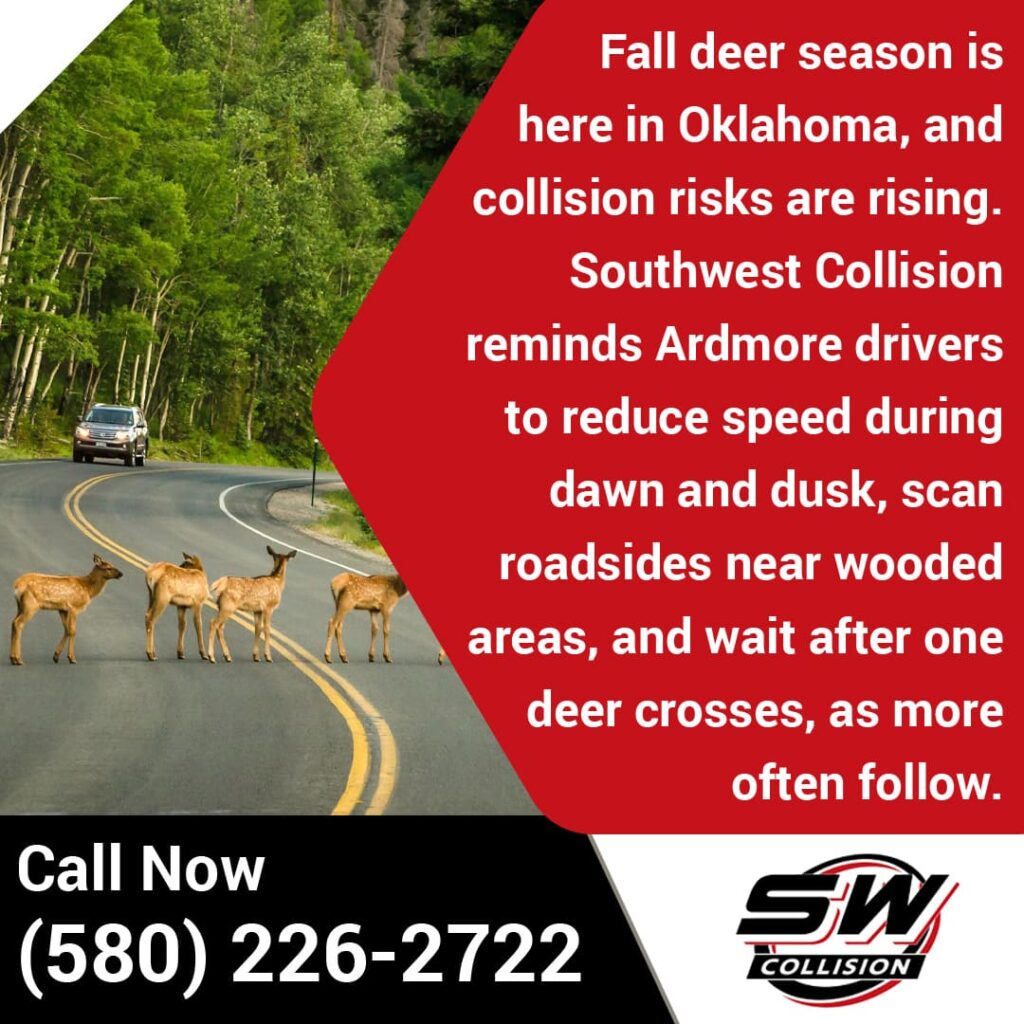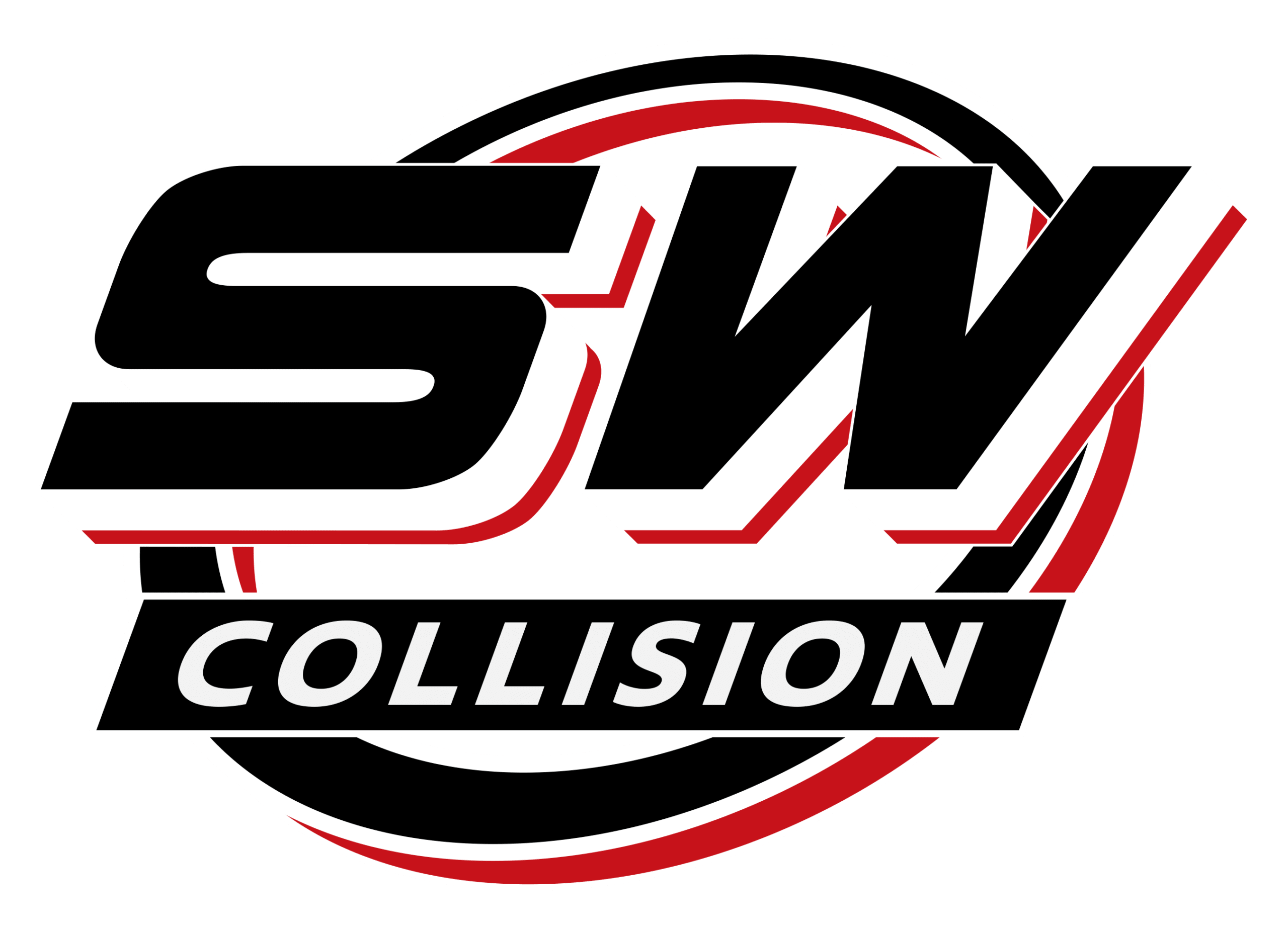Fall brings beautiful foliage and cooler temperatures to Oklahoma, but it also marks the peak season for deer-vehicle collisions. Between October and December, deer activity increases dramatically as animals enter their mating season and migrate in search of food. For drivers in southern Oklahoma, understanding how to prevent these accidents and knowing what to do afterward can save lives and money.
Deer-vehicle collisions cause more than 100 deaths and over $1 billion in vehicle damage annually across the United States. Oklahoma is ranked about 28th in the nation for deer collisions, but rural areas like Carter County see much higher numbers during the busy fall months of October to December, when deer are most active.
Drivers who experience vehicle damage from a deer strike can rely on our team at Southwest Collision, a trusted collision repair shop in Ardmore, OK. We provide accurate assessments and professional repairs that restore both safety and appearance.

Key Takeaways
1. October Through December is Peak Season
Oklahoma drivers face a 1 in 126 chance of hitting an animal. Dawn and dusk present the highest risk. Slow down in rural areas and stay alert near wooded zones.
2. Deer Travel in Groups
One deer crossing means others likely follow. Stop completely and wait 30 seconds before proceeding to avoid secondary collisions.
3. Document Everything Immediately
Photos and police reports are critical for insurance claims. Deer collisions fall under comprehensive coverage. Contact your insurer within 24 hours.
4. Hidden Damage Requires Professional Assessment
Deer impacts can cause severe structural damage beneath visible issues. Only a certified collision center in Ardmore with diagnostic equipment can identify all affected areas.
5. Choose Quality Auto Body Collision Repair
OEM parts and trained technicians protect your safety and investment. Quality car collision repair facilities provide lifetime warranties on workmanship.
Why Fall is Peak Season for Deer Collisions in Oklahoma
Deer behavior changes significantly during autumn. The breeding season, known as the rut, occurs from October through December. During this time, bucks become less cautious and more active, often crossing roads without warning.
Dawn and dusk present the highest risk periods. Deer feed primarily during these low-light hours, moving between bedding and feeding areas. Oklahoma’s rural highways see increased deer movement during these times, especially near wooded areas and agricultural fields.
Vehicle traffic also increases during fall. Hunting season brings more vehicles to rural roads. Shorter daylight hours mean more people drive during peak deer movement times. This combination creates dangerous conditions for collisions.
Understanding Oklahoma Deer Collision Statistics
The Oklahoma Department of Wildlife Conservation tracks deer-related accidents throughout the state. The data reveals important patterns that can help drivers stay safe.
Monthly Deer Collision Rates in Oklahoma
| Month | Collision Risk Level | Primary Factor |
| January–March | Low | Deer less active, post-rut period |
| April–June | Moderate | Does with fawns, increased movement |
| July–September | Low–Moderate | Normal feeding patterns |
| October–December | Very High | Breeding season, increased activity |
According to State Farm’s annual study, Oklahoma drivers have a 1 in 126 chance of hitting an animal, slightly higher than the national average of 1 in 139. Carter County, where Ardmore is located, experiences above-average collision rates due to its mix of highways, rural roads, and significant deer populations.
Prevention Tips for Oklahoma Drivers
Avoiding deer collisions requires awareness and defensive driving techniques specific to Oklahoma conditions.
Watch for Warning Signs
The Oklahoma Department of Transportation places deer crossing signs in high-activity areas. These yellow diamond signs mark proven collision hotspots. Slow down and stay alert when you see these markers.
Scan roadsides constantly, especially near wooded areas and fields. Deer often pause at road edges before crossing. Look for eye reflections in your headlights, which appear as bright spots in the darkness.
Adjust Your Driving During Peak Times
Plan routes to avoid high-risk roads during dawn (5:00-7:00 AM) and dusk (5:00-8:00 PM). If you must travel during these hours, reduce speed by 5-10 mph below posted limits in rural areas.
Use high beams when possible. Increased visibility gives you extra seconds to react. Remember to dim the lights for oncoming traffic.
Remember, Deer Travel in Groups
One deer crossing means others likely follow. A doe crossing the road often has fawns trailing behind. Bucks may chase does across highways during the rut.
Stop completely if you see a deer cross. Wait 30 seconds before proceeding. Scan both directions before continuing your drive.
Vehicle Modifications That Help
Upgraded headlights improve visibility on rural roads. LED or HID bulbs illuminate roadsides better than standard halogen bulbs, giving you more time to spot deer.
What to Do Immediately After Hitting a Deer
Despite precautions, collisions still occur. Knowing the proper steps protects you and prepares you for the repair process.
Safety Comes First
Pull to a safe location away from traffic. Turn on hazard lights immediately. Do not approach an injured deer, as they can cause serious injuries when frightened or in pain.
Call 911 if anyone is injured or if the deer blocks traffic. Oklahoma law requires reporting accidents involving property damage over $300 or any injuries.
Document the Incident
Take photos of vehicle damage from multiple angles. Photograph the accident scene, including road conditions and location markers. These images help with insurance claims and repair estimates.
Get a police report number if officers respond. Insurance companies often require official documentation for comprehensive claims. Note the exact location, time, and weather conditions.
Contact Your Insurance Provider
Most deer collisions fall under comprehensive coverage, not collision coverage. Call your insurance company within 24 hours. Provide them with photos, police report numbers, and detailed descriptions of damage.
Ask about rental car coverage while repairs are completed. Many policies include this benefit but require specific procedures to activate it. After documenting the incident and contacting your insurance provider, visiting a trusted auto collision repair facility helps get your vehicle properly assessed and restored to safe, drivable condition.
Understanding Deer Collision Damage
Deer impacts create specific damage patterns different from other accidents. Front-end collisions typically damage hoods, bumpers, grilles, and headlights. A full-grown Oklahoma white-tailed deer weighs 150-300 pounds, enough force to cause severe structural damage.
Windshield damage occurs when deer roll onto the hood. Side impacts happen when deer run into moving vehicles. These collisions damage doors, mirrors, and quarter panels.
Hidden damage often exists beneath visible issues. Radiators, air conditioning condensers, and suspension components suffer damage even in seemingly minor collisions. Frame damage can occur in high-speed impacts.
Choosing the Right Collision Repair Shop in Ardmore, OK
Proper repairs restore safety and value to your vehicle. Selecting a qualified collision repair shop in Ardmore, OK, makes a significant difference in repair quality and duration.
What to Look for in a Collision Repair Shop
OEM (Original Equipment Manufacturer) parts maintain your vehicle’s original safety standards and warranty coverage. Aftermarket parts may cost less but can compromise performance and resale value. A certified collision center in Ardmore that uses OEM parts provides better long-term results.
Training and certifications matter. Technicians trained in modern repair techniques understand how to work with advanced safety systems, aluminum bodies, and high-strength steel. Look for shops whose staff receive regular training updates.
The Repair Process for Deer Collision Damage
Quality car collision repair follows systematic steps to restore your vehicle properly.
Damage assessment comes before work begins. Technicians inspect visible damage and use diagnostic tools to identify hidden issues. This thorough inspection prevents surprise problems during repairs.
Parts ordering takes 3-7 days, typically. OEM parts may require longer lead times than aftermarket alternatives. Your repair shop should provide realistic timelines during the estimate process.
Repair work involves multiple stages. Body technicians straighten or replace damaged panels. Paint specialists match your vehicle’s exact color and apply professional finishes.
Quality checks happen throughout the process. Proper alignment, paint matching, and parts fitment require skill and attention to detail. Reputable shops stand behind their work with warranties covering workmanship and paint.

Why Southwest Collision is Your Best Choice for Auto Body Collision Repair
When deer collision damage affects your vehicle, you need a collision repair shop that understands both the technical demands and the stress you’re experiencing.
Southwest Collision has served Ardmore for many years, building trust through quality work and honest service. Joe Jilge, who took ownership in 2024, brings over two decades of collision repair experience to every project.
We follow OEM repair procedures for accurate restoration. Our state-of-the-art equipment handles everything from minor dent repair to complete frame straightening. Advanced diagnostic tools identify hidden damage that other shops might miss.
Our warranty demonstrates our commitment to quality. Workmanship and paint are covered for as long as you own your vehicle. OEM parts come with manufacturer warranties for additional protection.
We work directly with insurance companies to streamline the claims process. Our team handles paperwork, communicates with adjusters, and advocates for proper repairs. You focus on getting back to normal while we handle the details.
Get Professional Auto Collision Repair in Ardmore
Deer collisions disrupt your life and compromise your vehicle’s safety. Don’t trust repairs to inexperienced shops or settle for substandard parts.
Call Southwest Collision at (580) 226-2722 or email at sw.collision@yahoo.com for professional collision repair in Ardmore, OK. Our team provides free estimates, works with all insurance companies, and restores vehicles to pre-accident condition.
We serve Ardmore and the nearby areas throughout Carter County. Whether you need minor bodywork or extensive structural repairs, we have the skills, equipment, and commitment to do the job right.
Visit us at 2416 N Commerce Street to see our facility and meet our team. Experience the difference that comes from working with a locally owned, certified collision center in Ardmore that puts quality and customer service above everything else.
